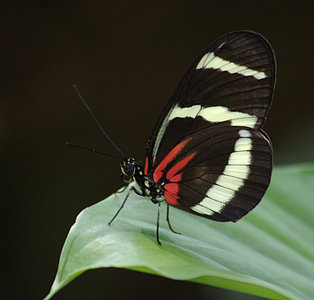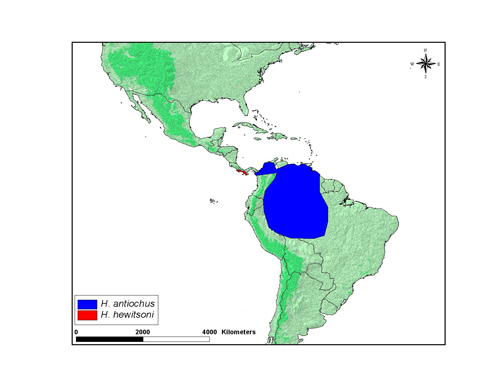Heliconius hewitsoni
Andrew V. Z. Brower and Margarita BeltránIntroduction
Heliconius hewitsoni is a cognate of H. sapho in the pupal-mating clade of Heliconius, with a restricted allopatric ditribution on the Pacific slope of Costa Rica and western Panama. It is involved in Müllerian mimicry with the H. cydno-cognate H. pachinus.
Characteristics
Early stages: Eggs are yellow and approximately 1.2 x 0.8 mm (h x w). Females usually place 20 to 40 eggs on growing shoots of the host plant. Mature larvae have a yellow and green body with yellow scoli and black head; length is around 0.3 cm. Caterpillars are gregarious (Brown, 1981). Pupae are pale yellow to pale brown, with well-marked black veins and black spines. Pupation often takes place in groups (DeVries, 1997).
Adult: A distinctive black butterfly with yellow transverse bands on fore- and hindwings. H. hewitsoni is very similar in general appearance to its Müllerian mimic H. pachinus. However, the two are easily separated as follows: the anterior part of the proximal yellow forewing band in H. hewistoni is in the discal cell, while in H. pachinus it is distal to the discal cell. Forewing length: 34-41 mm.
Geographical Distribution
Heliconius hewitsoni is distributed in the province of Chiriqui (Panama) and the Pacific slopes of Costa Rica. The map below shows an approximate representation of the geographic distribution of this species. The original data used to draw these maps are derived from Brown (1979) which is available at Keith S. Brown Jr. (1979). Ecological Geography and Evolution in Neotropical Forests.
Habits
H. hewitsoni occurs from sea level to 1,500 m in forest. Usually individuals fly rapidly and in the canopy. The males sit on female pupae a day before emergence, and mating occurs the next morning, before the female has completely eclosed. Adults roost at night in large groups on twigs or tendrils over water (Brown, 1981).
Host plant: H. hewitsoni larvae feed primarily on plants from the genus Passiflora, subgenus Astrophea (Brown, 1981). In Costa Rica they feed on Passiflora pittieri (DeVreis, 1997)
References
Brown K. S. 1981 The Biology of Heliconius and Related Genera. Annual Review of Entomology 26, 427-456.
DeVries P. J. 1997 The Butterflies of Costa Rica and Their Natural History, Volume I: Papilionidae, Pieridae, Nymphalidae Princeton University Press, Baskerville, USA.
Lamas, G. (ed.) 2004 Atlas of Neotropical Lepidoptera. Checklist: Part 4A Hesperioidea - Papiionoidea. Gainesville: Scientific Publishers/Association of Tropical Lepidoptera.
Title Illustrations

| Scientific Name | Heliconius hewitsoni |
|---|---|
| Location | captive, Sophia M. Sachs Butterfly House in Chesterfield, Missouri, USA |
| Specimen Condition | Live Specimen |
| Identified By | Andrew V. Z. Brower |
| Life Cycle Stage | adult |
| View | ventral |
| Source | Can you identify this? |
| Source Collection | Flickr |
| Image Use |
 This media file is licensed under the Creative Commons Attribution-NonCommercial-ShareAlike License - Version 2.0. This media file is licensed under the Creative Commons Attribution-NonCommercial-ShareAlike License - Version 2.0.
|
| Copyright | © 2008 capnr0n |
About This Page

Middle Tennessee State University, Murfreesboro, Tennessee, USA

University of Cambridge, Cambridge, UK
Correspondence regarding this page should be directed to Andrew V. Z. Brower at and Margarita Beltrán at
Page copyright © 2010 and
 Page: Tree of Life
Heliconius hewitsoni .
Authored by
Andrew V. Z. Brower and Margarita Beltrán.
The TEXT of this page is licensed under the
Creative Commons Attribution License - Version 3.0. Note that images and other media
featured on this page are each governed by their own license, and they may or may not be available
for reuse. Click on an image or a media link to access the media data window, which provides the
relevant licensing information. For the general terms and conditions of ToL material reuse and
redistribution, please see the Tree of Life Copyright
Policies.
Page: Tree of Life
Heliconius hewitsoni .
Authored by
Andrew V. Z. Brower and Margarita Beltrán.
The TEXT of this page is licensed under the
Creative Commons Attribution License - Version 3.0. Note that images and other media
featured on this page are each governed by their own license, and they may or may not be available
for reuse. Click on an image or a media link to access the media data window, which provides the
relevant licensing information. For the general terms and conditions of ToL material reuse and
redistribution, please see the Tree of Life Copyright
Policies.
- First online 18 February 2007
- Content changed 12 August 2008
Citing this page:
Brower, Andrew V. Z. and Margarita Beltrán. 2008. Heliconius hewitsoni . Version 12 August 2008 (under construction). http://tolweb.org/Heliconius_hewitsoni/72941/2008.08.12 in The Tree of Life Web Project, http://tolweb.org/









 Go to quick links
Go to quick search
Go to navigation for this section of the ToL site
Go to detailed links for the ToL site
Go to quick links
Go to quick search
Go to navigation for this section of the ToL site
Go to detailed links for the ToL site